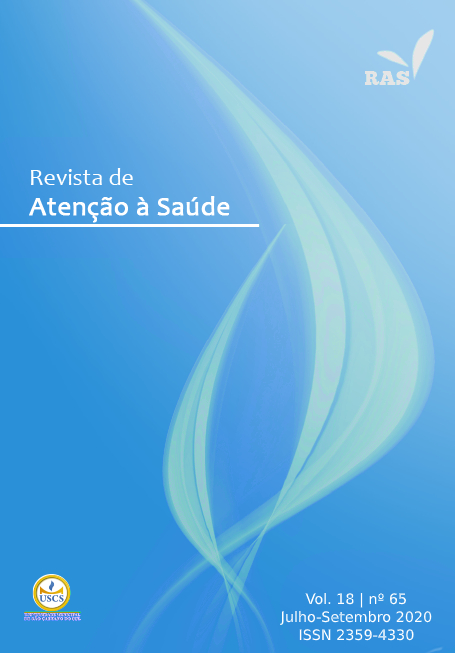EFEITO TERAPÊUTICO DO ALLIUM SATIVUM L. N NO CONTROLE DA HIPERTENSÃO ARTERIAL
Keywords:
Allium Sativum L., hipertensão, alho, fitoterapia.Abstract
Introdução: A influência das plantas medicinais sobre os níveis pressóricos se deve a existência de metabólitos secundários, ou seja, princípios ativos, que são produtos sintetizados pelas plantas, determinando seu principal efeito farmacológico. Objetivo: Verificar por meio de revisão bibliográfica, o potencial terapêutico do alho no controle da hipertensão arterial. Materiais e Métodos: Foram consultadas as seguintes bases de dados: Pubmed, Scielo, e Lilacs a fim de identificar artigos científicos publicados no período de 2008 à 2018. A busca nas fontes citadas, foi realizada com base nos Descritores em Ciências da Saúde, tendo como palavras-chave: allium sativum L., alho, hipertensão arterial, fitoterapia, pressão alta e plantas medicinais. Resultados: Nos artigos selecionados, poucos foram os casos de adversidades no consumo, como incômodos gastrointestinais leves, náuseas e azia. Foi visto que ainda não há um consenso sobre o real mecanismo de ação da alicina e qual a melhor forma de preparação mais biodisponível ao organismo. Conclusões: Os estudos mostraram que o alho é uma excelente alternativa para a hipertensão arterial sistêmica, pois foi eficaz tanto em animais como em humanos, possuindo efeitos similares aos de fármacos consolidados do mercado, podendo atuar de forma complementar ao medicamento.
Downloads
References
LOPES MCL, MARCON SSA hipertensão arterial e a família: a necessidade do cuidado familiar. Rev. Esc. Enferm. 2009; 43(2):343-350.
SERAFIM TS, JESUS ES, PIERIN AMG. Influência do conhecimento sobre o estilo de vida saudável no controle de pessoas hipertensas. Acta Paul Enferm. 2010; 23(5):658-664.
BONFIM-SILVA R, SOUZA-RIOS DL. Polimorfismos genéticos do sistema renina angiotensina-aldosterona na doença arterial coronariana e na hipertensão arterial sistêmica. UninCor. 2012; 10(1):28-40.
MONTEIRO LZ, SPINATO IL, SILVA CAB, SANTOS ZMSA, JUNIOR RMM. Nível de Conhecimento do Profissional de Educação Física frente a alunos com hipertensão arterial nas academias de ginástica. Rev. Bras. cineatropom. desempenho hum. 2010; 12 (4): 262-268.
NILSON EAF, JAIME PC, RESENDE DO. Iniciativas desenvolvidas no Brasil para a redução do teor de sódio em alimentos processados. Rev. Panam Salud Pública. 2012; 34(4):287–92.
OLIVEIRA EP, et al. A variedade da dieta é fator protetor para a pressão arterial sistólica elevada. Cardiol. 2012; 98(4):338-343.
ABREU RNDC, ROCHA LA, ALBUQUERQUE ALP, FIALHO AVM, MOREIRA TMM. Análise da produção do conhecimento em enfermagem acerca da temática hipertensão arterial, 1995 a 2005. Online Braz. J. Nur. 2006; 5 (3).
OLIVEIRA CJ, ARAÚJO TL. Plantas medicinais: usos e crenças de idosos portadores de hipertensão. Rev. Eletrônica Enferm. 2007; 9(1):93-105.
¬¬¬¬¬¬¬¬¬Ministério da Saúde (BR). Portaria Nº 971, de 3 de Maio de 2006. Aprova a Política Nacional de Práticas Integrativas e Complementares (PNPIC) no Sistema Único de Saúde. Diário Oficial da União. Brasília, 4 maio.2006; Seção 1, p. 20.
Ministério da Saúde (BR). Agência Nacional de Vigilância Sanitária. Resolução de Diretoria Colegiada (RDC) n.º 48, de 16 de março de 2004. Dispõe sobre o registro de medicamentos fitoterápicos. Diário Oficial [da] República Federativa do Brasil, Brasília, DF, 18 mar. 2004. Seção 1.
TOMAZZONI, MI, NEGRELLE RRB, CENTA ML. Fitoterapia popular: a busca instrumental enquanto prática terapêutica. Texto Contexto Enferm. 2006;15(1): 115-121.
SILVEIRA PF, BANDEIRA MAM, ARRAIS PSD. Farmacovigilância e reações adversas às plantas medicinais e fitoterápicos: uma realidade. Rev.bras.farmacogn. 2008; 18(4):p.618-626.
JUNIOR JCN. Hipertensão arterial sistêmica: um estudo sobre a ótica ocidental e oriental e o uso de fitoterapia e ervas medicinais no brasil. [Monografia]. São José dos Campos: Unisaude/Centro de Esudos Firval; 2014.
TEIXEIRA K. Plantas Medicinais que Podem Causar Alteração na Pressão Arterial e interação com Anti-Hipertensivos [Monografia]. Criciúma: Universidade do Extremo Sul Catarinense- UNESC; 2012.
TALBOTT SM, HUGHES K. Suplementos dietéticos para profissionais de saúde. Rio de Janeiro (RJ): Guanabara Koogan: 2015.
ASHRAF R, KHAN RA, ASHRAF I, QURESHI AA. Effects of Allium sativum (garlic) on systolic and diastolic blood pressure in patients with essential hypertension. Pak. J. Pharm. Sci. 2013; 6 (5): 859-63.
RIED K, FRANK OR, STOCKS NP. Aged garlic extract lowers blood pressure in patients with treated but uncontrolled hypertension: a randomised controlled trial. Maturitas. 2010; 67(2):144-150.
RIED K, TRAVICA N, SALI A. The effect of aged garlic extract on blood pressure and other cardiovascular risk factors in uncontrolled hypertensives: the AGE at Heart trial. Integr Blood Press Control. 2016; 9(9).
SOBENIN IA, ANDRIANOVA IV, FOMCHENKOV IV, GORCHAKOVA TV, OREKHOV AN. Time-released garlic powder tablets lower systolic and diastolic blood pressure in men with mild and moderate arterial hypertension. Hypertens Res.2009; 32(6):433.
BASHIRI, J. The Effect of Regular Aerobic Exercise and Garlic Supplementation on Lipid Profile and Blood Pressure in Inactive Subjects. Bashiri J Zahedan J Res Med Sci. 2015; 17(4).
NAKASONE Y, NAKAMURA Y, YAMAMOTO T, YAMAGUCHI H.. Effect of a traditional Japanese garlic preparation on blood pressure in prehypertensive and mildly hypertensive adults. Exp Ther Med. 2013; 5(2):399-405.
BHARDWAJ K, VERMA MK, VERMA N, BHARDWAJ S, MISHRA S. Effect of long term supplementation of active garlic allicin in reducing blood pressure in hypertensive subjects. Int J Adv Med. 2017; 2(3):231-234.
MAHDAVI-ROSHAN M, NASROLLAHZADEH J, MOHAMMAD ZADEH A, ZAHEDMEHR A. Does Garlic Supplementation Control Blood Pressure in Patients with Severe Coronary Artery Disease? A Clinical Trial Study. Iran Red Crescent Med J. 2016; 18(11)
RIED K, FRANK OR, STOCKS NP. Aged garlic extract reduces blood pressure in hypertensives: a dose–response trial. Eur J Clin Nutr. 2013; 67(1) 64.
AMAGASE, H. Clarifying the real bioactive constituents of garlic. J Nutr. 2006; 136 (3): 716S-725S.
CORNELISSE VA, FAGARD RH. Effects of endurance training on blood pressure, blood pressure–regulating mechanisms, and cardiovascular risk factors. Hypertension: 2005; 46 (4):667-675.
FUGH‐BERMAN A. Herbs and dietary supplements in the prevention and treatment of cardiovascular disease. Prev. Cardiol: 2000; 3(1):24-32.
MACAN H, UYKIMPANG R, ALCONCEL M, TAKASU J, RAZON R, AMAGASE H, NIIHARA Y.. Aged garlic extract may be safe for patients on warfarin therapy. J Nutr: 2006; 136(3):793S-795S.
LAWSON LD, GARDNER CD. Composition, stability, and bioavailability of garlic products used in a clinical trial. J Agric Food Chem:2005; 53(16): 6254-6261.
HARAUMA A, MORIGUCHI T. Aged garlic extract improves blood pressure in spontaneously hypertensive rats more safely than raw garlic. J Nutr. 2006; 136 (3):769S-773S.
AL-QATTAN KK, THOMSON M, AL-MUTAWA'A S, AL-HAJERI, D, DROBIOVA H, ALI M. Nitric oxide mediates the blood-pressure lowering effect of garlic in the rat two-kidney, one-clip model of hypertension. J Nutr. 2006; 136(3): 774S-776S.
BENAVIDES GA, SQUADRITO GL, MILLS RW, PATEL HD, ISBELL TS, PATEL RP, DARLEY-USMAR VM, DOELLER JE, KRAUS DW. Hydrogen sulfide mediates the vasoactivity of garlic. Proc Natl Acad Sci. 2007; 104 (46):17977-17982.
MELETIS CD. Cleansing of the human body: a daily essential process. Altern Complement Ther.2001; 7(4):196-202.
PARK BM, CHA AS, KIM HY, KANG DK, YUAN K, CHUN H, KIM SH. Fermented garlic extract decreases blood pressure through nitrite and sGC-cGMP-PKG pathway in spontaneously hypertensive rats. J Funct Foods: 2016; 22: 156-165.
HIRAMATSU K, TSUNEYOSHI T, OGAWA T, MORIHARA N. Aged garlic extract enhances heme oxygenase-1 and glutamate-cysteine ligase modifier subunit expression via the nuclear factor erythroid 2–related factor 2–antioxidant response element signaling pathway in human endothelial cells. Nutr Res:2016; 36 (2) 143-149.
DUBEY H, SINGH A, PATOLE AM, TENPE CR. Antihypertensive effect of allicin in dexamethasone-induced hypertensive rats. Integr Med Res. 2017; 6 (1): 60-65.
ALMEIDA A, SUYENAGA ES. Ação farmacológica do alho (Alliumsativum L.) e da cebola (Allium cepa L.)sobreo sistema cardiovascular: revisão. Nutrire Rev. Soc. Bras. Aliment. Nutr. 2009; 34(1):185-197.
LAMARÃO R, NAVARRO F. Aspectos nutricionais promotores e protetores das doenças cardiovasculares. RBONE: 2012; 1(4):57-70.
Downloads
Published
Issue
Section
License
Copyright (c) 2020 Revista de Atenção à Saúde

This work is licensed under a Creative Commons Attribution-NonCommercial-ShareAlike 4.0 International License.
Policy Proposal for Journals offering Free Delayed Access
Authors who publish in this magazine agree to the following terms:
- Authors maintain the copyright and grant the journal the right to the first publication, with the work simultaneously licensed under a Creative Commons Attribution License after publication, allowing the sharing of the work with recognition of the authorship of the work and initial publication in this journal.
- Authors are authorized to assume additional contracts separately, for non-exclusive distribution of the version of the work published in this magazine (eg, publishing in institutional repository or as a book chapter), with the acknowledgment of the authorship and initial publication in this journal.
- Authors are allowed and encouraged to publish and distribute their work online (eg in institutional repositories or on their personal page) at any point before or during the editorial process, as this can generate productive changes, as well as increase impact and citation of the published work (See The Effect of Open Access).









